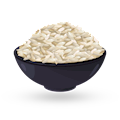Best Burkinabé Foods
MAIN INGREDIENTS
Babenda is a popular one-pot dish from Burkina Faso based on bitter greens such as spinach, kale, mustard greens, or swiss chard. What makes this dish quite interesting is the addition of fermented locust beans, called sumbala (or irú), imparting a pungent flavor that is reminiscent of blue cheese.
Sumbala is additionally mashed together with smoked or dried fish in order to add some protein to the dish. The whole concoction is typically combined with rice to make babenda, a homogenous mass of bitter greens, soumbala, rice, and fish.
Riz gras, the French term for fat rice, is Burkina Faso's national one-pot dish, consisting of white rice, tomato paste, and vegetables such as eggplants, carrots, onions, chili peppers, and garlic that are boiled together in a thick rice stew and served with a few strands of raw onions on top.
If meat is used in the dish, it is browned at the beginning of the cooking process. Peanut oil is heavily used in the making of riz gras, giving it its name. Although the dish is not flashy, it is a perfect comfort food - proteins, carbohydrates, and vegetables all in one dish.
MAIN INGREDIENTS
Tô or saghbo is a dough-based, ugali-like dish consisting of cooked millet, corn, or sorghum that is stirred vigorously until it is formed into a smooth paste. It is consumed with various stews and sauces which are made from meats or vegetables.
The dish is most commonly paired with okra sauce, made by slowly simmering okra in water with seasonings such as salt and pepper. Tô is never eaten on its own, and it will always be accompanied either by soups, stews, or sauces.
MAIN INGREDIENTS
Ragout d'igname is a yam and beef stew that is popular in most West African countries, especially in Burkina Faso. The key ingredients used in the dish are yams, beef, garlic, ginger, onions, carrots, peppers, and tomatoes. This casserole-like dish is typically seasoned only with salt and pepper, and when the yam is soft and the sauce thickens, ragout d'igname is ready to be consumed, preferably piping hot.
TasteAtlas food rankings are based on the ratings of the TasteAtlas audience, with a series of mechanisms that recognize real users and that ignore bot, nationalist or local patriotic ratings, and give additional value to the ratings of users that the system recognizes as knowledgeable. TasteAtlas Rankings should not be seen as the final global conclusion about food. Their purpose is to promote excellent local foods, instill pride in traditional dishes, and arouse curiosity about dishes you haven’t tried.










